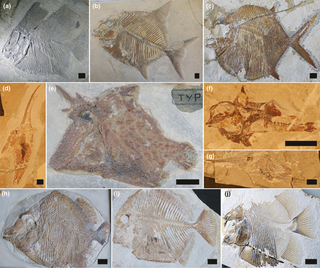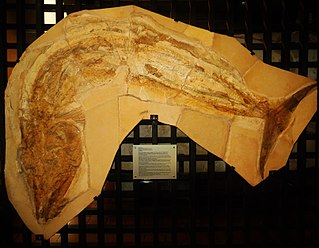
Pycnodus is an extinct genus of ray-finned fish from the Eocene period. It is wastebasket taxon, although many fossils from Jurassic or Cretaceous are assigned to this genus, only Eocene species, P. apodus is valid. As its name suggests, it is the type genus of Pycnodontiformes.

Pycnodontiformes is an extinct order of primarily marine bony fish. The group first appeared during the Late Triassic and disappeared during the Eocene. The group has been found in rock formations in Africa, Asia, Europe, North and South America.

Vinctifer is an extinct genus of prehistoric bony fish erected by David Starr Jordan in 1919.
Luisiella is an extinct genus of prehistoric bony fish that lived during the Kimmeridgian stage of the Late Jurassic epoch. Fossils of the genus have been found in either the Cañadón Calcáreo Formation or Cañadón Asfalto Formation in Chubut Province, Argentina.

Ainia is an extinct genus of prehistoric ray-finned fish that lived during the Kimmeridgian stage of the Late Jurassic epoch. It contains a single species, A. armata, known from the famous Solnhofen Limestone of Germany. It is a distant relative of the bowfin, although it is more closely related to genera such as Caturus and Osteorachis.

Asthenocormus is an extinct genus of large marine pachycormiform ray-finned fish. It contains a single species, A. titanius. A member of the edentulous suspension feeding clade within the Pachycormiformes, fossils have been found in the Upper Jurassic plattenkalks of Bavaria, Germany.

Acentrophorus is an extinct genus of prehistoric freshwater and marine ray-finned fish from the Roadian to the Wuchiapingian of England, Germany (Kupferschiefer), Italy and Russia. There may also be a Triassic occurrence in Australia.

Anaethalion is an extinct genus of prehistoric marine and freshwater ray-finned fish related to modern tarpons and ladyfish. It is known from the Late Jurassic to the Early Cretaceous of Europe and northeasterrn Asia, roughly encompassing the Tethys Ocean.

Coelodus is an extinct genus of marine and possibly freshwater pycnodont fish. It contains only one definitive species, C. saturnusHeckel, 1854, from the Late Cretaceous of Slovenia. Other species from the Late Jurassic to the Eocene have also been attributed to this genus based on isolated dental elements, but their assignment to Coelodus is uncertain, and this genus likely represents a non-monophyletic wastebasket taxon. A potential diagnostic trait is a prearticular tooth row with three regular highly elongated teeth.

Coccolepis is an extinct genus of prehistoric marine ray-finned fish in the family Coccolepididae. Originally including most species within the family, it is now restricted to two species from the Late Jurassic Solnhofen Limestone of Germany. The holotype of C. bucklandi, designated and described by Louis Agassiz, was thought to be lost but was later rediscovered in Neuchâtel.
Proleptolepis is an extinct genus of ray-finned fish belonging to the family Leptolepidae.

Saurorhynchus is an extinct genus of carnivorous bony fish that lived during the Early and Middle Jurassic epochs. Fossils have been found in Europe and North America (Canada). It is commonly found in pelagic and lagoonal deposits, but mostly marine. Largest specimens can grow up to 1.9 metres (6.2 ft).
Plesiococcolepis is an extinct genus of prehistoric ray-finned fish. It belongs to the family Coccolepididae and is known from the Early Jurassic of Lingling-Hengyang, Hunan, China.

The Solnhofen Limestone or Solnhofen Plattenkalk is a collective term for multiple Late Jurassic lithographic limestones in southeastern Germany, which is famous for its well preserved fossil flora and fauna dating to the late Jurassic (Kimmeridgian-Tithonian). The paleoenvironment is also often referred to as the Solnhofen Archipelago. The Solnhofen Archipelago was located at the northern edge of the Tethys Ocean as part of a shallow epicontinental sea and is firmly a part of the Mediterranean realm.

Pycnodontidae is an extinct family of ray-finned fishes, ranging from the Jurassic period until the Eocene. It was the largest and most derived family of the successful Mesozoic fish order Pycnodontiformes, and the only member of it to survive into the Cenozoic.
This list of fossil fishes described in 2016 is a list of new taxa of jawless vertebrates, placoderms, acanthodians, fossil cartilaginous fishes, bony fishes and other fishes of every kind that have been described during the year 2016, as well as other significant discoveries and events related to paleontology of fishes that occurred in the year 2016. The list only includes taxa at the level of genus or species.

Orthogonikleithrus is a genus of extinct ray-finned fish that lived during the Late Jurassic period. It lived in lagoonal and restricted shallow subtidal zones.

Piranhamesodon pinnatomus is a pycnodontiform fish from the Late Jurassic. It was described from the Plattenkalk deposits of the Solnhofen Formation, in Bavaria, Germany. It is notable for having sharp, serrated teeth highly reminiscent of a piranha, a highly unusual trait as most other species in the order Pycnodontiformes were shellfish eaters with flat, crushing teeth. It is also the oldest known bony fish with this trait. This unusual combination is reflected in its genus name, which is a combination of piranha and the frequent pycnodontiform genus suffix Mesodon. Fossils of other fish found in the same area have torn fins possibly attributable to this species.

Neoproscinetes is a genus of extinct pycnodontid fish from the Cretaceous Santana Formation of Brazil. Fossils of this species have also been discovered in the Riachuelo Formation.

Thiollierepycnodus is an extinct genus of pycnodontid fish from the Jurassic of France and Germany. The animal was originally assigned to the genus Pycnodus, but it was given its own genus in 2020. Thiollierepycnodus was 25 cm long, with a laterally flat body and comparatively large fins, indicating that it was a reef fish of considerable manoeuvrability. Its durophagous dentition strongly suggests a diet of hard-shelled organisms. It contains a single species, Thiollierepycnodus wagneri.

















